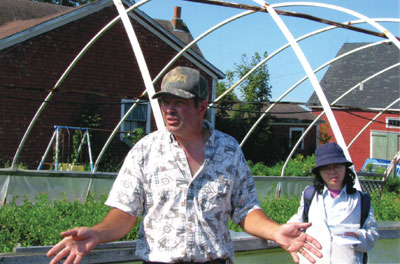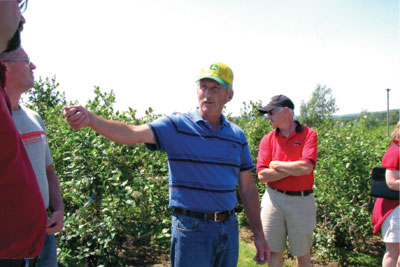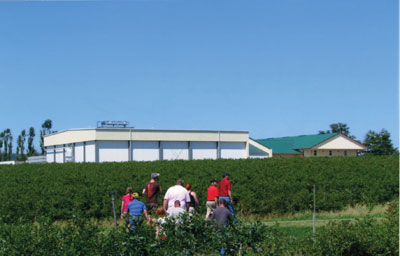
Features
Production
Research
High bush blueberry production catching on in Nova Scotia
December 2, 2009 By Dan Woolley
Nova Scotia’s high bush blueberry industry might be the little brother to the province’s 1,000 growers and 38,000 acres of wild blueberries but interest in production is growing.
Nova Scotia’s high bush blueberry industry might be the little brother to the province’s 1,000 growers and 38,000 acres of wild blueberries but interest in production is growing.

|
| Glen Higbee of New Ross, N.S., describes his process for propagating high bush blueberry plants for resale. Advertisement
|
There are currently an estimated 74 growers of high bush blueberries in the province and more acreage going into production, particularly on the south shore and in Cape Breton. Last January, Horticulture Nova Scotia agreed to represent the high bush blueberry industry, letting growers join with other berry groups the organization represents.
During the 2009 berry tour, co-hosted by Horticulture Nova Scotia and Agra Point, participants visited two Annapolis Valley high bush blueberry commercial growers, including Atlantic Canada’s largest high bush grower, Blueberry Acres, owned by the Nova Agri Group.
Blueberry Acres, which is located near Sheffield Mills, N.S., was first planted to blueberries in the late 1950s with three varieties: Burlington, Jersey and Coville. Nova Agri’s co-owners, Earl and Bobby Kidston, bought Blueberry Acres in the early 1990s and gradually expanded the operation from its original 60 acres to 180 acres and 24 different varieties. Most recently, they planted several new varieties: Rouble, an early, fresh variety derived from a wild cultivar, and three new varieties – Aurora, Draper and Liberty – that can be machine-harvested.
Bluebery Acres is likely the only farm in the Annapolis Valley to sell the Jersey blueberry variety, according to Bobby, the operation’s manager. He adds that although it is a very sweet berry, Jersey must be pruned regularly or its berries will lose size. Pruning also eliminates diseased canes “and disease pruning is probably our biggest expense,” said Bobby.
 |
|
| Bobby Kidston, manager of Blueberry Acres, talks about the operation’s extensive plot of high bush blueberries. |
|
 |
|
| Berry tour visitors walk past Nova Agri Group’s storage and processing facility located at Sheffield Mills, N.S. (Photos by Dan Woolley)
|
The biggest disease threat at Blueberry Acre is anthracnose. The operation has been achieving very good control with two applications of Bravo, explained Bobby, who also likes to use Pristine.
Even though sprays are used on the main plantings, Blueberry Acres also maintains a six-year-old organic blueberry plot that is fertilized with a mix of fishmeal and seaweed extract.
Harvesting usually starts on Aug. 1 and continues to about Nov. 1, utilizing up to 500 pickers. Picking begins about 10 to 12 days after the blueberries look ready to pick. This helps to maximize the berry’s Brix level. Once picked, the blueberries are processed, cleaned, packed, and then stored in Nova Agri’s controlled atmosphere refrigeration facility.
Blueberry Acres also operates a you-pick that will see about 15,000 visitors between Aug. 6 and Sept. 6.
Besides Blueberry Acres, Nova Agri also owns a high bush operation in Argentina, which helps the operation extend its production cycle. The Argentine farm begins harvesting in September, just as the Nova Scotia farm is starting to wind down the season.
Even with this production power, Bobby admits, “We’re just breaking even. The market price is low right now.”
A lot of Argentine growers are now going out of business because of high shipping costs to North American markets where Argentine berries are only receiving $5 per flat in Los Angeles, Bobby explains. He adds that some growers are burning their fruit instead of shipping it at a loss and are even converting to organic production.
He said he is concerned about shipping into the Boston and Toronto markets because the price they would be paid would not defray their freight costs. “That makes us nervous,” he said.
His wild blueberry counterparts are in a similar cost-price squeeze, getting only 35 cents per pound, while their cost of production is 70 cents per pound. In contrast, the Nova Scotia wild blueberry producers were getting $1.05 per pound two years ago.
International high bush blueberry production is predicted to increase from the current 650 million pounds to 1.3 billion pounds by 2013 said Bobby. In light of this, Nova Agri is expanding its fresh fruit production into juice, dried products and nutraceuticals.
At the opposite end of the size scale, Glen Higbee of New Ross, N.S., grows two acres of high bush blueberries for local grocery stores, farmers’ markets and roadside sales. He also grows the plants for resale to other growers and nurseries.
Higbee believes Nova Scotia has an advantage in the high bush blueberry industry since its blueberries are the last to come to market in North America. Last year, he noted, the price for the domestic harvest was ruined when the South American crop appeared early on the market.
When it comes to production, Higbee says it is important to have the soil pH tested with the ideal pH being about five. High bush blueberry plants do not grow well in heavy ground. He also suggested incorporating peat moss into the rows to hold water around the roots.
High bush plants are also sensitive to chemicals so Higbee recommends growers not apply Round Up herbicide near them, nor perform weed wiping too close. He also avoids the high bush variety, Patriot, because of its susceptibility to mummy berry. He does like Northland, a biennial berry that can have its size manipulated through pruning.
When fertilizing, he applies 10-9-9 twice during the season, ensuring it is an ammonium sulphate, and not aluminum sulphate, which will burn the plants.
Print this page